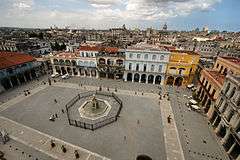Old Havana
Old Havana (Spanish: La Habana Vieja) is the city-center (downtown) and one of the 15 municipalities (or boroughs) forming Havana, Cuba. It has the second highest population density in the city and contains the core of the original city of Havana. The positions of the original Havana city walls are the modern boundaries of Old Havana.
Old Havana La Habana Vieja | |
|---|---|
Municipality of Havana | |
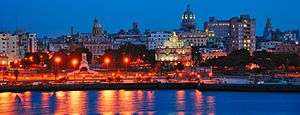 | |
 Location of Old Havana in Havana | |
| Coordinates: 23°08′09.4″N 82°21′30.0″W | |
| Country | |
| Province | |
| Wards (Consejos Populares) | Belén, Catedral, Jesús María, Plaza Vieja, Prado, San Isidro, Tallapiedra |
| Area | |
| • Total | 4 km2 (2 sq mi) |
| Elevation | 50 m (160 ft) |
| Population (2004)[2] | |
| • Total | 97,984 |
| • Density | 24,000/km2 (63,000/sq mi) |
| Time zone | UTC-5 (EST) |
| Area code(s) | +53-7 |
| Official name | Old Havana and its Fortification System |
| Type | Cultural |
| Criteria | iv, v |
| Designated | 1982 (6th session) |
| Reference no. | 204 |
| State Party | Cuba |
| Region | Latin America and the Caribbean |
Old Havana is a UNESCO World Heritage Site.
History
.jpg)
Havana was founded by the Spanish in 1519 in the natural harbor of the Bay of Havana. It became a stopping point for the treasure laden Spanish galleons on the crossing between the New World and the Old World. In the 17th century, it was one of the main shipbuilding centers. The city was built in baroque and neoclassical styles. Many buildings have fallen into ruin in the latter half of the 20th century, but a number are being restored. The narrow streets of Old Havana contain many buildings, accounting for perhaps as many as one-third of the approximately 3,000 buildings found in Old Havana. It is the ancient city formed from the port, the official center and the Plaza de Armas.
In 1555, Old Havana was destroyed and burned by the French corsair Jacques de Sores. The pirate had taken Havana easily, plundering the city and burning much of it to the ground. After limiting the scarce defenders, De Sores left without obtaining the enormous wealth that he was hoping to find in Havana. The city remained devastated and set on fire. Since the incident, the Spanish brought soldiers and started building fortresses and walls to protect the city. Castillo de la Real Fuerza was the first fortress built; initiated in 1558, the construction was overseen by the engineer Bartolomé Sanchez.
Old Havana resembles Cadiz and Tenerife. Alejo Carpentier called it "de las columnas"(of the columns), but it could also be named for the gateways, the revoco, the deterioration and the rescue, the intimacy, the shade, the cool, the courtyards... In her there are all the big ancient monuments, the forts, the convents and churches, the palaces, the alleys, the arcade, the human density. The Cuban State had undertaken enormous efforts to preserve and to restore Old Havana through the efforts of the Office of the Historian of the City, which was directed by Eusebio Leal. The reconstruction effort successfully transformed Old Havana into a tourist attraction, and also resulted in Leal becoming recognized as Old Havana's de facto Mayor.[3][4]
Main sights
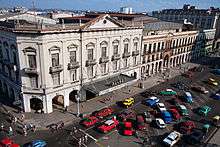
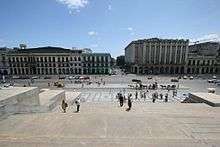
- The Malecón is the avenue that runs along the seawall at the northern shore of Havana, from Old Havana to the Almendares River.
- The Paseo del Prado, Havana is the street that forms the western edge of Old Havana, being its boundary with Centro Habana.
- Castillo del Morro, picturesque fortress guarding the entrance to Havana bay. The construction of the castle Los Tres Reyes del Morro owed to the step along in Havana of the English pirate Sir Francis Drake. The king of Spain arranged its construction on a big stone which was known by the name of El Morro. He sent the field master Juan de Texeda, accompanied of the military engineer Battista Antonelli, who came to Havana in 1587 and began the task at once.
- La Cabaña fortress, located on the east side of the Havana Bay. The most impressive fortress of the Spanish colony was La Cabaña. It impresses with its 18th-century walls, constructed at the same time as El Morro. Every night at 9 p.m., some soldiers dressed in suits of the epoch shoot from her the “el cañonazo de las nueve”, (gunshot of the nine). It went off every day to warn of the closing of the doors of the wall that surrounded the city.
- San Salvador de la Punta Fortress, In the shore opposite to the Castle of El Morro, at the beginning of the curve of El Malecon, there rises the fortress of San Salvador de la Punta, of minor architectural dimensions. It was constructed in 1590, and in 1629 the Chapter of Havana decided, to defend better the port, to join her in the night with the El Morro by using a thick chain that prevented the entry of enemy ships.
- Castillo de la Real Fuerza, The fortress or (lit.) Castle of the Royal Army is another big monument that closes the Plaza de las Armas. It was the first big fortification of the city, initiated in 1558 on the ruins of an ancient fortress. In the same year, the Crown sent to Cuba the engineer Bartolomé Sanchez, supervised by 14 official and main stonemasons in order to reconstruct the castle, which had been set fire and destroyed by the French corsair Jacques de Sores.
- Catedral de San Cristóbal, the most prominent building on the Plaza de la Catedral. The cathedral was raised on the chapel after 1748 by order of the bishop from Salamanca, Jose Felipe de Trespalacios. It is one of the most beautiful and sober churches of the American baroque.
- National Capitol, styled after the Panthéon (Paris), looking similar to the U.S. Capitol.[5]
- Galician Center, Central Park, The Galician Center, of neobarroque style was established as a social club of the Galician emigrants between 1907 and 1914. Built on the Theater Tacon (nowadays Great Theater of Havana), it was open during the Carnival of 1838 with five masked dances.
- Plaza de Armas – the main touristic square. The origin of its name is military, since from the end of the 16th century the ceremonies and the military events took place here.
- Gran Teatro de la Havana, the Great Theater of Havana is famous, particularly for the acclaimed National Ballet of Cuba and its founder Alicia Alonso. It sometimes performs the National Opera. The theater is also known as concert hall, Garcia Lorca, the biggest in Cuba.
- The Museum of the Revolution, located in the former Presidential Palace, with the boat Granma on display in front of the museum.
- San Francisco de la Habana Basilica, Habana Vieja, The set of church and convent of San Francisco de Asis, byline of the year 1608, and it was reconstructed in 1737.
Threats
In 2008, Hurricane Ike destroyed many structures in Old Havana, overturning years of conservation work directed at the iconic antiquated buildings of the area. Not only did it damage historic buildings, but it forced many of Old Havana's residents to flee for safety.[6] The threats that hurricanes pose adds to an already tenuous state for Old Havana's many historic buildings. Age, decay, and neglect combine with natural factors in a complex set of threats to the long-term preservation of this historic old town.[7]
UNESCO Heritage site
In 1982, La Habana Vieja was inscribed in the UNESCO World Heritage List.[8] A safeguarding campaign was launched a year later to restore the authentic character of the buildings.
Photo gallery
.jpg)
 Great Theatre of Havana
Great Theatre of Havana
- Cathedral of Havana
- Hotel Inglaterra across Prado
.jpg) Palacio de los Capitanes Generales, Havana, Cuba
Palacio de los Capitanes Generales, Havana, Cuba
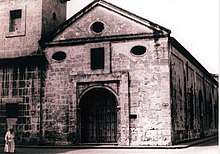
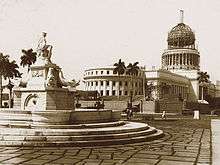
 Church of Angel Custodio
Church of Angel Custodio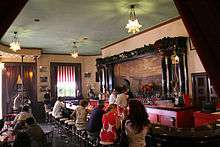
 Old Havana street view
Old Havana street view
Twin towns – sister cities
Old Havana is twinned with the following cities:
See also
References
- Statoids (July 2003). "Municipios of Cuba". Retrieved October 6, 2007.
- Atenas.cu (2004). "2004 Population trends, by Province and Municipality" (in Spanish). Archived from the original on July 14, 2006. Retrieved October 6, 2007.
- https://week.com/2020/07/31/eusebio-leal-who-oversaw-renewal-of-old-havana-dies-at-77/
- https://www.nytimes.com/reuters/2020/07/31/world/europe/31reuters-people-eusebio-leal-obituary.html
- Frank Herbst, Cuba – Handbuch für individuelles Reisen, Reise Know-How Verlag 2006
- Irving, Mark (September 10, 2008). "Hurricane Ike batters historic Old Havana". The Independent. UK.
- Sanchez, Ray (May 3, 2009). "Havana's Historic Architecture at Risk of Crumbling Into Dust". Sun-Sentinel.
- Habana Vieja Archived June 1, 2016, at the Wayback Machine – UNESCO World Heritage List
- Towns twinned with Sintra Archived June 8, 2008, at the Wayback Machine
External links
| Wikimedia Commons has media related to Old Havana. |
- Links to sites with casa particular and travel info on Old Havana
- Hotels in Old Havana Travel and tourism
- Old Havana Restoring Hidden Treasured Murals by Vanessa Bauza, Sun Sentinel, April 11, 2004
- Particular houses in Old Havana Cheap accommodation in Old Habana
